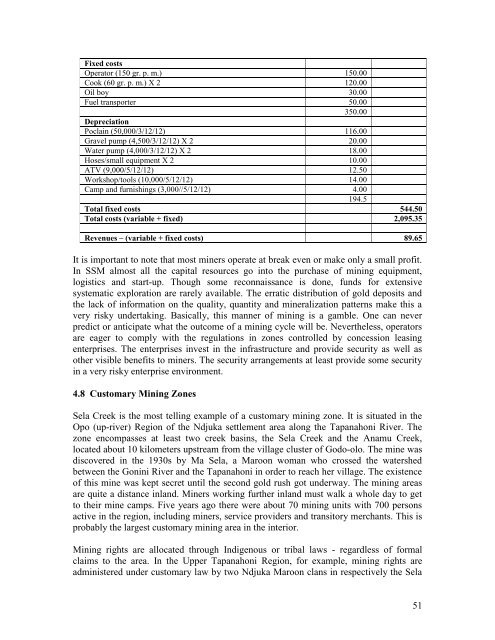SITUATION ANALYSIS OF THE SMALL-SCALE GOLD ... - WWF
SITUATION ANALYSIS OF THE SMALL-SCALE GOLD ... - WWF
SITUATION ANALYSIS OF THE SMALL-SCALE GOLD ... - WWF
Create successful ePaper yourself
Turn your PDF publications into a flip-book with our unique Google optimized e-Paper software.
Fixed costs<br />
Operator (150 gr. p. m.) 150.00<br />
Cook (60 gr. p. m.) X 2 120.00<br />
Oil boy 30.00<br />
Fuel transporter 50.00<br />
350.00<br />
Depreciation<br />
Poclain (50,000/3/12/12) 116.00<br />
Gravel pump (4,500/3/12/12) X 2 20.00<br />
Water pump (4,000/3/12/12) X 2 18.00<br />
Hoses/small equipment X 2 10.00<br />
ATV (9,000/5/12/12) 12.50<br />
Workshop/tools (10,000/5/12/12) 14.00<br />
Camp and furnishings (3,000//5/12/12) 4.00<br />
194.5<br />
Total fixed costs 544.50<br />
Total costs (variable + fixed) 2,095.35<br />
Revenues – (variable + fixed costs) 89.65<br />
It is important to note that most miners operate at break even or make only a small profit.<br />
In SSM almost all the capital resources go into the purchase of mining equipment,<br />
logistics and start-up. Though some reconnaissance is done, funds for extensive<br />
systematic exploration are rarely available. The erratic distribution of gold deposits and<br />
the lack of information on the quality, quantity and mineralization patterns make this a<br />
very risky undertaking. Basically, this manner of mining is a gamble. One can never<br />
predict or anticipate what the outcome of a mining cycle will be. Nevertheless, operators<br />
are eager to comply with the regulations in zones controlled by concession leasing<br />
enterprises. The enterprises invest in the infrastructure and provide security as well as<br />
other visible benefits to miners. The security arrangements at least provide some security<br />
in a very risky enterprise environment.<br />
4.8 Customary Mining Zones<br />
Sela Creek is the most telling example of a customary mining zone. It is situated in the<br />
Opo (up-river) Region of the Ndjuka settlement area along the Tapanahoni River. The<br />
zone encompasses at least two creek basins, the Sela Creek and the Anamu Creek,<br />
located about 10 kilometers upstream from the village cluster of Godo-olo. The mine was<br />
discovered in the 1930s by Ma Sela, a Maroon woman who crossed the watershed<br />
between the Gonini River and the Tapanahoni in order to reach her village. The existence<br />
of this mine was kept secret until the second gold rush got underway. The mining areas<br />
are quite a distance inland. Miners working further inland must walk a whole day to get<br />
to their mine camps. Five years ago there were about 70 mining units with 700 persons<br />
active in the region, including miners, service providers and transitory merchants. This is<br />
probably the largest customary mining area in the interior.<br />
Mining rights are allocated through Indigenous or tribal laws - regardless of formal<br />
claims to the area. In the Upper Tapanahoni Region, for example, mining rights are<br />
administered under customary law by two Ndjuka Maroon clans in respectively the Sela<br />
51
















